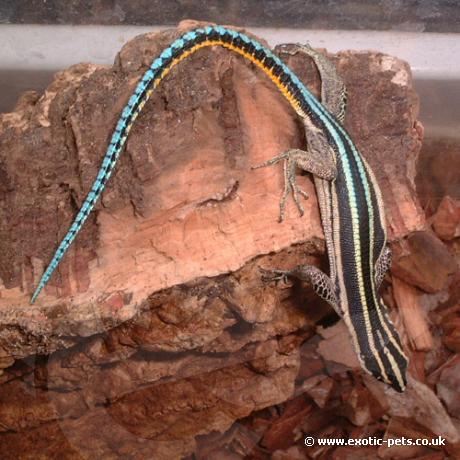

With striking colours, this small Neon Blue Tailed Tree Lizard is a MUST for any collection. Found in lowland forests and open woodlands high within the African trees.
This is a small species of tree lizard reaching a maximum length of 12cm, averaging 9-11cm. They have a flattened body and tail that helps them glide from tree to tree, the distance can be more than 10m.
They have a black body with cream stripes running from head to base of tail . Their tail has a central row of striking bright blue spots with a yellow fringe along the sides. The throat, chest and limbs are cream. Males tend to have an orange belly whereas females are orange/grey.
The recorded sighting of this beautiful lizard is from Uganda and Bukoba, Tanzania, ranges widely in West Africa, South-West to Angola, North-West to Sierra Leone.
They can be found living in lowland forests or open woodlands mainly on vertical tree trunks.
One important piece of information for this lizard, keep them in an escape proof vertical enclosure. They can easily fit between the glass doors and through large vents. It is wise to use draft excluder on sliding glass and ensure any vents/holes are too small for this small species to squeeze through.
We use the vertical Exo Terra Terrariums, these provide the height which this species requires. Place a number of branches of different widths and artificial plants inside your enclosure, ground hides are not required as these rarely hunt or hide on the floor.
There is not much information on this species, therefore these temperatures are from our own findings and research.
Using a termostat, provide a basking area of 38-40C, the ambient temperature should range between 24-26C. Allow a night time drop to 18-20C, during winter this can be lowered to 10-15C. UV lighting is required, we would recommend a 5% output.
Lightly mist the enclosure each morning and evening to allow your lizard to drink. The humidity levels should range between 60-80%.
Due to their size, small prey should be offered. Crickets, hatchling locusts, fruit flies, house flies, mini mealworms, small wax worms and small garden spiders. Dust live foods with a vitamin supplement twice a week.